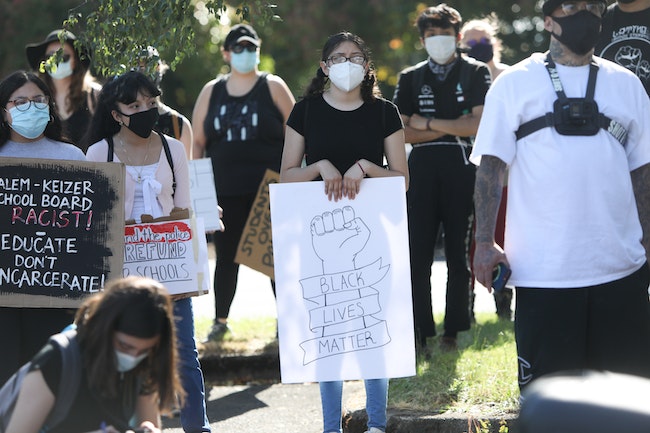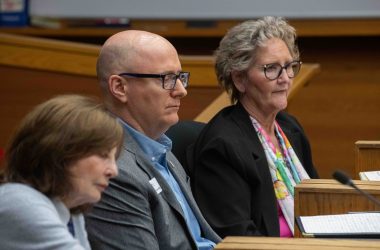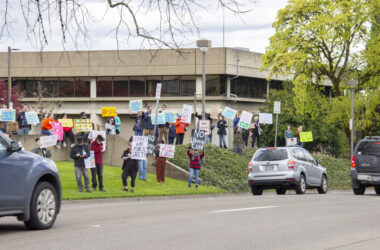A 50-year-old program of police in Salem-Keizer schools has become a flashpoint in local discussions about racial justice as activists who have long pushed for changes to school discipline say people in power can no longer ignore them.
A petition organized by youth group Latinos Unidos Siempre now has gathered nearly 1,000 signatures urging an end to the school resource officers, director Sandra Hernández–Lomelí said. Instead, they’re urging the district to spend the roughly $1 million a year on counselors and educators to support students of color in schools.
Dozens of parents and local citizens have spoken against that plan since the effort got underway June 9. They have been writing to school board leaders supporting police in schools.
Over the past two weeks, administrators in the Salem-Keizer School District and police leaders have met with Latino, Black and Native American community leaders, parents and students to discuss the future of police in schools. About 100 young people with Latinos Unidos Siempre, many current Salem-Keizer students or recent graduates, protested outside the district office on Thursday, June 18, to press their case.
Benny Williams, president of the Salem-Keizer NAACP, signed the petition, saying the movement has created the first significant talks in years between social justice groups and district leaders about changes to the discipline system. He said police in schools aren’t the only reason Black students are more frequently suspended, expelled and arrested, but said they are part of a systemic problem with how the district punishes students.
“It contributes to African-American students being disciplined at a higher rate than the rest of the student body,” he said.
District administrators, some parents and teachers, and the police departments involved say the program helps keep schools safe and gives students positive role models. Administrators don’t dispute that school discipline disproportionately harms Black and Latino students, but believe those disparities can be addressed through better data collection and training.
Officers assigned to schools investigate child abuse, a task many students and citizens don’t realize falls under their jurisdiction, district administrators said. Such investigations can take about 40% of their time, according to Lt. Debbie Aguilar, who supervises eight Salem police officers assigned to the program. Officers also participate in threat assessments that determine whether a child is likely to harm another person.
But for years, social justice and community groups like the NAACP and Latinos Unidos Siempre have challenged the need for police in schools, contending that officers are part of a disciplinary system where Black and Latino students are disproportionately suspended, expelled and referred to law enforcement.
As district administrators now discuss making changes to the program, including expanding training and changing officer uniforms to appear less threatening, many say the underlying issue is that students of color will not feel or be safe in schools as long as police are present.
 Alex Buron, organizer with Latinos Unidos Siempre. (Amanda Loman/Salem Reporter)
Alex Buron, organizer with Latinos Unidos Siempre. (Amanda Loman/Salem Reporter)
“This might be the only chance we have to actually change this oppressive system,” said Alex Buron, an organizer with Latinos Unidos Siempre, at a protest last week.
The Salem City Council and the Salem-Keizer School Board are expected to vote on budgets for the coming year at meetings Monday and Tuesday, respectively. While the school officer contracts are not up for renewal, councilors and board members are likely to address the recent call to defund the program.
On Monday’s city council agenda, one councilor is calling for a work session to consider the city’s agreement with the school district for resource officers.
The history
Started in 1968 as a way to reduce crime and improve young people’s perception of police, the purpose of Salem-Keizer’s school resource officer program remains largely the same as it was 50 years ago, even as the number of officers in local schools and the tasks they take on has expanded.
The first U.S. school resource officer program started in Flint, Michigan, in 1953. Fifteen years later, Salem adopted a similar program that had one officer in uniform make visits to schools at the request of school officials or teachers.
 A 1969 Salem Police Department report describes the first year of the school liaison officer program (Courtesy/Salem-Keizer Public Schools)
A 1969 Salem Police Department report describes the first year of the school liaison officer program (Courtesy/Salem-Keizer Public Schools)
The department described the program as a crime prevention and public relations tool in its 1969 annual report.
“He improves the relationship between young people and the police. He creates a better image of the police so the young person recognizes the police as friends and protectors rather than as a punitive agent,” the report explained. School safety wasn’t mentioned.
That year, the officer appeared at schools 63 times.
During the 1969-70 school year, the police department expanded the program, with one full-time and one part-time officer assigned as school liaisons.
Officers presented in classrooms but also made more informal visits to schools, eating lunch with students. At one junior high school, the officer concentrated on “a small group of boys who were classed as problems by the school authorities.”
The department started a ride-along program so students could “experience the duties and problems of police” and visit the jail and police station.
Since the 1970s the role of school resource officers shifted from mentorship to crime prevention, facilitating programs like Drug Abuse Resistance Education.
In 1978, the Salem Police Department added two more officers to school duty, referring to them as school liaisons.
DOCUMENT: 1978 Statesman Journal article
At the time there were three officers stationed full-time at the high schools and other officers who split time between the middle and elementary schools, according to a Statesman Journal article.
Sgt. Calvin Steward told the newspaper that rather than moving toward permanent teaching assignments at schools, officers would concentrate on school-related problems like vandalism and burglaries in surrounding residential areas.
In 1978, he also told the Statesman Journal police were planning on making more appearances at the Oregon School for the Blind and the Oregon School for the Deaf.
Four years later, eight officers served the five middle schools and four high schools within city limits.
After a fiscal crisis in 1980, the school district started picking up the tab for two sheriff’s deputies assigned full time to McNary High School and Whiteaker Middle School. And Salem police started asking for the district to cover its costs, the Statesman Journal reported.
McNary’s principal told the newspaper that the officers were “99% counselors” working to prevent juvenile delinquency. The officer taught students about drunken driving, drug abuse and shoplifting in addition to investigating school-related crime, the principal said in 1982.
DOCUMENT: 1982 Statesman Journal article
Later in the 1980s, more federal money became available to school districts for police officers.
John van Dreal, interim director of safety and risk management for Salem-Keizer, said that money came with a shift in name. Police in schools were no longer called liaisons. They were known as “school resource officers.”
“They wanted to say ‘Look, this police officer is a resource to the kids,’” van Dreal said.
 John van Dreal, Salem-Keizer school district director of security and risk management. (Amanda Loman/Salem Reporter)
John van Dreal, Salem-Keizer school district director of security and risk management. (Amanda Loman/Salem Reporter)
In the wake of the Columbine High School shooting, federal funding again increased to bolster police presence at schools across the country.
Congress appropriated $180 million for the program in 2000 and 2002, helping hire nearly 7,200 school officers nationwide, according to a 2013 Congressional research report. That money dried up in 2005, according to the report.
The pushback
Police and discipline in Salem-Keizer schools was an early issue that Latino community members began organizing around. Levi Herrera-Lopez, executive director of Mano a Mano, said the district’s racial demographics changed substantially in the early 1990s, when a large number of Latino families moved to the area from cities in California.
Some of those students were involved in gangs, and the following years included a large school and police crackdown on gang activity.
Herrera-Lopez, then a teenager, was an early member of Latinos Unidos Siempre, which worked to deter young Latinos from gang involvement and to push back against anti-immigrant policies and policies they felt targeted Latino youth.
They cited as an example a school district gang intervention manual which detailed clothing, slang and symbols believed to be associated with gangs. The document included expressions and phrases that were common Spanish words and Mexican cultural symbols like the Virgen de Guadalupe.
As a result of such stereotypes, police assumed many Latino teenagers were involved in gangs because of how they dressed or who they spent time with, regardless of their actual behavior, Herrera-Lopez said. The result was a real problem – gang activity – became a reason for surveillance of Latino teens.
“It came down to the look of the youth,” Herrera-Lopez said.
Resource officers today
Salem-Keizer now has 11 officers in schools through contracts with Salem and Keizer police departments and the Marion County Sheriff’s Office. Each of the district’s six high schools has an assigned officer. The other five are stationed at middle schools, and each officer is responsible for other schools in their area.
The program’s goals remain much the same as in 1968, van Dreal said – preventing crime by building relationships with students, serving as a mentor and providing on-site policing services such as responding to students with weapons.
“The ultimate goal is to keep kids from being arrested and ending up in the school-to-prison pipeline,” he said.
Salem’s school resource officers use a model called the triad, which focuses on mentoring and informal counseling, education and law enforcement.
“It is not arrest first. That is not at all our focus. Our focus is on the kids, is on helping them be the best kid they can be and learning good behaviors,” Aguilar said.
The Salem Police Department, Marion County Sheriff’s Office and Keizer Police Department all declined to make a school resource officer available for an interview.
School officers attend a two-day training each summer before school starts which includes an update from the state Department of Human Services, a presentation on the triad model, implicit bias, restorative justice, the school-to-prison pipeline and the district’s equity lens.
Van Dreal said he restarted that training in 2018 after a version offered by the state was cut. It’s now three or four hours annually, which he acknowledged wasn’t adequate.
“We need to make that a longer training with some more depth to it,” he said.
The officers also get specific training in investigating child abuse and in assessing student threats.
Lieutenant Trevor Wenning with the Keizer Police Department said the presence of an officer in schools can provide a psychological benefit for teachers who fear harm from intruders or violent students.
“The same can be said for the students. There are students who attend school in fear daily. This fear can be generated from a variety of sources ranging from physical bullying to social media bullying to seclusion and isolation from peers,” Wenning said in an email. “An officer can provide a sense of security for the student as well as being a resource to help prevent future incidents of bullying and other crimes.”
The effectiveness of the school officers is difficult to measure. Salem-Keizer records when students are suspended, expelled or arrested but don’t note whether school officers were involved in the action. There is no ready measurement to show the results of police working as mentors.
School officers are supervised by their agency, not the school district, but van Dreal said he provides feedback about officer performance and complaints. Aguilar said the Salem Police Department hasn’t reviewed the program, but each year the district surveys the schools about the program.
Van Dreal last reviewed the program for the district in 2017, assessing how well officers responded to school needs by polling school administrators.
Most school administrators rated officers highly on their relationships with school administrators, education of students and performance during crises on campus. They said improvements were needed in communication about scheduling and relationship building with students. In response, van Dreal modified the contracts to be more explicit about expectations for leave, backup officers and communication.
He said the district hasn’t done a systematic review of resource officers’ role in school discipline or arrest rates or assessed whether they contribute to disproportionate discipline in local schools. Van Dreal reviews law enforcement and juvenile justice reports about arrests of minors and racial disparities, but said he hasn’t been able to get funding to improve data collection inside the district to better note which actions officers are involved in.
Williams, the NAACP president, said better data collection is needed to help community members understand where disparities arise.
Officers are not supposed to be involved in school discipline, which includes decisions to suspend or expel students, van Dreal said, though if an incident includes a crime, they may do a law enforcement investigation while district administrators handle school discipline. They may talk to students informally as mentors or try to gather information about an event like a fight, but school administrators are tasked with deciding whether an incident at school warrants discipline or a referral to the resource officer, he said.
Critics of the program say that’s not how officers actually work in schools.
 Alex Sosa Navarro holds up a sign during a protest outside of the Salem-Keizer school district offices on Thursday, June 18 to urge the district to cancel their contract for police officers in schools. (Amanda Loman/Salem Reporter)
Alex Sosa Navarro holds up a sign during a protest outside of the Salem-Keizer school district offices on Thursday, June 18 to urge the district to cancel their contract for police officers in schools. (Amanda Loman/Salem Reporter)
Alex Sosa Navarro, a 15-year-old McNary High School student, said he was questioned by his school’s officer earlier this year because he missed the bus and was late to class. The officer ultimately put him in detention, he said, rather than letting him go to class, even though he was surrounded by white students who were also running late.
“We’re just getting more oppressed in school by police,” Sosa Navarro said.
Dozens of mostly Latino students have shared similar stories for years at school board meetings, saying they’re often assumed to be causing problems or delinquent for conduct their white classmates get more leeway on.
Many of those speaking up say the first time they were suspended or expelled, or sometimes arrested was in elementary school over things like talking back to teachers or bringing a nail file to school.
Van Dreal said students may be confusing school officers with district security specialists. Officers should mostly be in hallways having informal conversations with kids, he said. They may ask why a student is late to class in an effort to see if there’s a life problem the officer can help fix.
“That may not be how it’s always perceived because if someone is already fearful of the police it doesn’t matter how that’s said. It can be very intimidating,” he said. He said he’s worked on training officers to use language more common in a school setting, rather than the language of police reports, where a school fight becomes an “assault.”
Herrera-Lopez said in the decades since he was a student at McNary High School, he’s seen improvement in both school discipline and the impact of officers in schools as the district has moved away from a zero tolerance approach to problems.
But he said the presence of officers in schools means students are more likely to be arrested or referred to police, and those referrals still disproportionately impact Black and Latino students.
He said that’s true even when schools have resource officers who want to be mentors and are kind and care about students.
“They’re not going to the police academy to be mentors. Some of them may be great mentors,” he said. But in schools, “they’re going to be law enforcement officers. I think that’s what we as a society need them to be.”
Deputy Chief George Burke recently provided Salem city councilors a summary of police arrests of students at schools from January 2017 to December 2018.
(Graphic by Saphara Harrell/Salem Reporter)
The numbers show nearly all arrests have been at McKay and North, the most racially diverse and poorest high schools in the district. The numbers do not include McNary High School because the officer stationed there works for the Keizer Police Department.
At McKay there were 25 arrests during that time period compared one at Sprague.
Van Dreal said those arrests may have been during a period of heightened gang activity at McKay, but doesn’t dispute that racial bias was likely a factor in the disparity. He said that bias, whether intended or not, may come from educators who are quicker to refer students of color to law enforcement.
“It drives those referrals. It’s the perception of the teacher about what is said, the attitude with which it’s said. If that all comes together in the perfect storm you’re going to see referrals go up for kids of color,” he said.
Aguilar said some of the arrest numbers could be related to more crimes being reported to officers at particular schools. She also said some students may want to press charges if there’s a fight, for instance.
“We don’t even want the kids to think that we’re making decisions based on anything other than the facts of the case. I understand when the kids look at that, they look at just the numbers, it must be that the police are only focusing on kids of color,” Aguilar said. “I think that it’s important for them to recognize the larger picture, sometimes there are mandatory arrests where we don’t have a choice.”
What’s next
Van Dreal and Aguilar said whether the resource officer program continues, police will still appear in local schools as teachers call 911 to report fights, suspicious people or other crimes.
They’re concerned ending the contracts would mean responding officers won’t be experienced dealing with students or know people in schools. Removing officers from schools would also lengthen the response time to a call.
But activists pushing to end the resource officer program see it as part of a shift in how Salem-Keizer approaches discipline and student behavior.
“When the students are getting into trouble … there’s a deeper problem. Students at such a young age should not be criminalized,” said Adriana Miranda, executive director of Causa and a member of the school district budget committee.
Critics want to see money now spent on police used to fund Black and Latino counselors and educators who understand that students acting out in class may be dealing with abuse, a mental illness or otherwise need help.
“If we invest in school social workers and therapists and psychologists and behavioral specialists that are trained to respond to traumas, then the teachers don’t need to call the police. They would have the support of these specialists that are trained to respond to these types of scenarios,” Miranda said.
Iton Udosenata, an assistant superintendent for Salem-Keizer, said it’s clear the district needs to make changes in communicating what the officers do, addressing implicit bias among their own employees and collecting better data about why and how students of color, especially Black and Latino students, are disciplined more frequently.
“Those are things within our district that we need to look closely at,” he said.
Correction: This article was updated to correct the number of signatures the Latinos Unidos Siempre petition has gathered.
SUPPORT ESSENTIAL REPORTING FOR SALEM – A subscription starts at $5 a month for around-the-clock access to stories and email alerts sent directly to you. Your support matters. Go HERE.
Contact reporter Rachel Alexander: [email protected] or 503-575-1241. Contact reporter Saphara Harrell at 503-549-6250, [email protected] or @daisysaphara.










